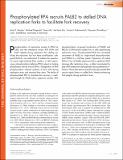| dc.contributor.author | Murphy, Anar K. | en_US |
| dc.contributor.author | Fitzgerald, Michael | en_US |
| dc.contributor.author | Ro, Teresa | en_US |
| dc.contributor.author | Kim, Jee Hyun | en_US |
| dc.contributor.author | Rabinowitsch, Ariana I. | en_US |
| dc.contributor.author | Chowdhury, Dipanjan | en_US |
| dc.contributor.author | Schildkraut, Carl L. | en_US |
| dc.contributor.author | Borowiec, James A. | en_US |
| dc.date.accessioned | 2015-03-02T17:39:01Z | |
| dc.date.issued | 2014 | en_US |
| dc.identifier.citation | Murphy, Anar K., Michael Fitzgerald, Teresa Ro, Jee Hyun Kim, Ariana I. Rabinowitsch, Dipanjan Chowdhury, Carl L. Schildkraut, and James A. Borowiec. 2014. “Phosphorylated RPA recruits PALB2 to stalled DNA replication forks to facilitate fork recovery.” The Journal of Cell Biology 206 (4): 493-507. doi:10.1083/jcb.201404111. http://dx.doi.org/10.1083/jcb.201404111. | en |
| dc.identifier.issn | 0021-9525 | en |
| dc.identifier.uri | http://nrs.harvard.edu/urn-3:HUL.InstRepos:14065457 | |
| dc.description.abstract | Phosphorylation of replication protein A (RPA) by Cdk2 and the checkpoint kinase ATR (ATM and Rad3 related) during replication fork stalling stabilizes the replisome, but how these modifications safeguard the fork is not understood. To address this question, we used single-molecule fiber analysis in cells expressing a phosphorylation-defective RPA2 subunit or lacking phosphatase activity toward RPA2. Deregulation of RPA phosphorylation reduced synthesis at forks both during replication stress and recovery from stress. The ability of phosphorylated RPA to stimulate fork recovery is mediated through the PALB2 tumor suppressor protein. RPA phosphorylation increased localization of PALB2 and BRCA2 to RPA-bound nuclear foci in cells experiencing replication stress. Phosphorylated RPA also stimulated recruitment of PALB2 to single-strand deoxyribonucleic acid (DNA) in a cell-free system. Expression of mutant RPA2 or loss of PALB2 expression led to significant DNA damage after replication stress, a defect accentuated by poly-ADP (adenosine diphosphate) ribose polymerase inhibitors. These data demonstrate that phosphorylated RPA recruits repair factors to stalled forks, thereby enhancing fork integrity during replication stress. | en |
| dc.language.iso | en_US | en |
| dc.publisher | The Rockefeller University Press | en |
| dc.relation.isversionof | doi:10.1083/jcb.201404111 | en |
| dc.relation.hasversion | http://www.ncbi.nlm.nih.gov/pmc/articles/PMC4137056/pdf/ | en |
| dash.license | LAA | en_US |
| dc.subject | Article | en |
| dc.title | Phosphorylated RPA recruits PALB2 to stalled DNA replication forks to facilitate fork recovery | en |
| dc.type | Journal Article | en_US |
| dc.description.version | Version of Record | en |
| dc.relation.journal | The Journal of Cell Biology | en |
| dash.depositing.author | Chowdhury, Dipanjan | en_US |
| dc.date.available | 2015-03-02T17:39:01Z | |
| dc.identifier.doi | 10.1083/jcb.201404111 | * |
| dash.contributor.affiliated | Chowdhury, Dipanjan | |


